SUNDAY
JANUARY 31 - 2016
Malcolm's
news
I had a walk
through Brook Meadow this morning where I met Malcolm
Phillips looking intently at the tangled vegetation on
the west bank of the river below the S-bend with his
camera at the ready. He had spotted something moving
which he thought could be a Water Rail. We have not
seen Water Rail on the meadow this winter, but,
despite half an hour's looking he saw nothing.
However, earlier Malcolm had been entertained by two
Goldcrests near the south bridge.
Brian's
news
I was not
entirely surprised to see the Summer Snowflake
outside the Lumley gate in full flower when I passed
by this morning.
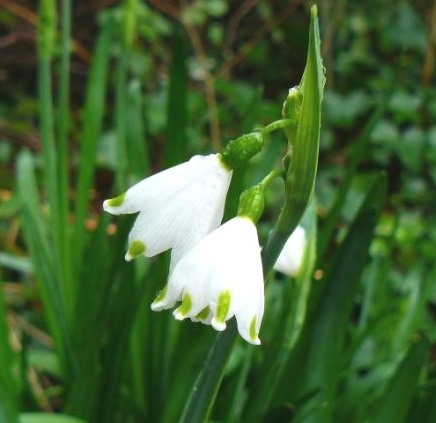
Although this is
early, Malcolm Phillips saw one in flower in Palmer's
Road Copse on Jan 1 this year. My previous earliest
flowering date on Brook Meadow for this misnamed plant
was on 01-Mar-15. This crazy winter is breaking all
records!
Fresh green leaves of
Hairy Garlic are showing well on the east end
of the Lillywhite's path though there are no flowers
as yet. The leaves have tiny hairs along the edges and
give a faint garlic smell when crushed.
A large Crack
Willow tree has come crashing down on the east
bank just north of the south bridge on Brook Meadow.
It is lying along the bank of the river so is not
blocking the flow of water, so could be left in situ
as a wildlife habitat.
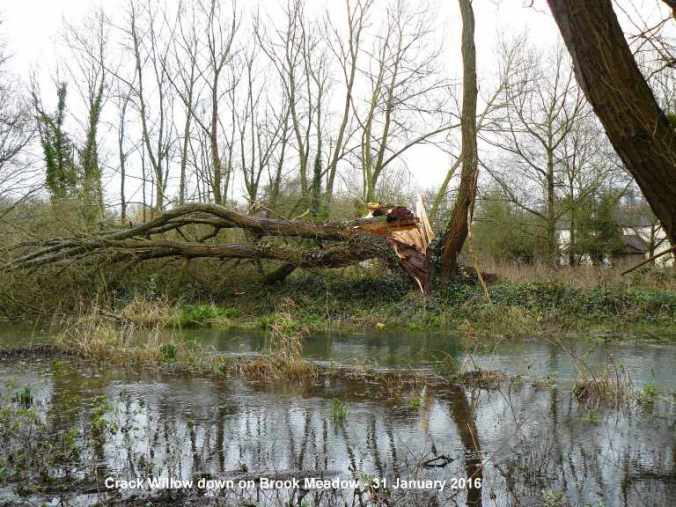
Peter's
news
Peter
Milinets-Raby managed to get an hour's birdwatching in
Emsworth Harbour before the fine drizzle arrived.
Peter says he does not bird watch in the rain! Ice,
snow, hurricanes, dust storms, blistering sunshine,
fog . . . yes! Rain . . .NO!
Emsworth Mill Pond: 8 Coot, 1 Cormorant.
Emsworth Harbour: 12 Red Breasted Merganser,
301 Brent Geese, 20 Coot, 3 Grey Plover, 17 Lapwing, 4
Turnstone, 3 Great Crested Grebes, 41 Shelduck, 2
Greenshank (RG//-+BYtag//-), 2 Teal, 2 Great
Black-backed Gulls (waiting for Slipper Millpond
nest?), 3 male and 3 female Goldeneye, 17 Knot, 25
Dunlin.
Off Mill Pond Outflow: 11 Dunlin, 1 Greenshank,
9 Wigeon, 2 Teal, 15 Brent Geese.
Beacon Square: 96 Knot, 16 Dunlin, 1 Ringed
Plover, 16 Brent Geese, 1 Shelduck, 26 Wigeon, 6 Teal.
See Peter's 2015
report for maps of these locations . . .
http://www.peterspurplepages.webspace.virginmedia.com/EmsworthWarblingtonReport2015_Update_2.pdf
Southleigh
Landfill
Hampshire
Ornithological Society has sent out a request for
information about landfill sites used by gulls to
which Caroline French responded. She informed them
that the large landfill site on the Emsworth Common
Road opposite Hollybank Woods in North Emsworth, which
used to attract thousands of gulls to feast on its
rich waste disposal, was closed in 2007 and is
undergoing restoration to create native woodland and
meadow grassland, according to Veolia information
available on the internet. Any further information on
such sites would be welcome.
FRIDAY
JANUARY 28 - 2016
Malcolm's
gallery
Malcolm
Phillips was out on Brook Meadow today in wind. This
did not stop him getting a number of good photos of
local wildlife, including a lovely Great Tit and a
bright yellow flower of Lesser Celandine. Lesser
Celandine is usually seen as a harbinger of spring,
but they have been out for several weeks around the
town this winter where there are many good displays.
Incidentally, they don't always have 8 petals like
this one. I went around counting the petals a few
years ago for interest and (from memory) they varied
from 5 up to 13.
Slavonian
Grebes
With reference
to the recent sighting of a Red-necked Grebe by Tony
Wootton at Keyhaven (see blog for Jan 26), Ralph
Hollins agrees that Slavonian Grebes are uncommon in
the Solent Harbours but thinks it worth keeping an eye
out for them as Bernie Forbes saw seven of them in the
water south of Thorney Island yesterday when he was on
East Head (see the SOS website).
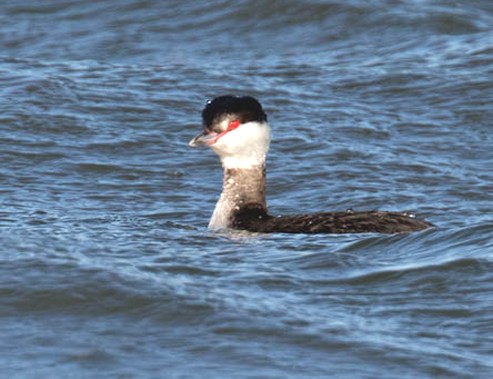
Ralph also wonders
whether we are now seeing the start of a period in
which Slavonian Grebes start to favour Chichester
Harbour in the same way that Black-necked Grebes used
to winter in good numbers in Langstone Harbour in the
1980s, though they have declined since then.
Interestingly, regarding Black-necked Grebes, Alan Cox
(in Birds of Hampshire p.131) thinks "Such long-term
fidelity to Langstone Harbour of a group whose size
runs counter to national trends, might suggest a
unique population perhaps originating from a specific,
but as yet unknown, breeding locality"
Robin
song
The
autumn/winter song of the Robin is typically rather
soft and wistful. However, Ralph Hollins has noted a
change in the last day or two today from the laid back
winter version to a much sharper, more aggressive
spring version. Here is one in full song that Malcolm
Phillips captured earlier in the year.
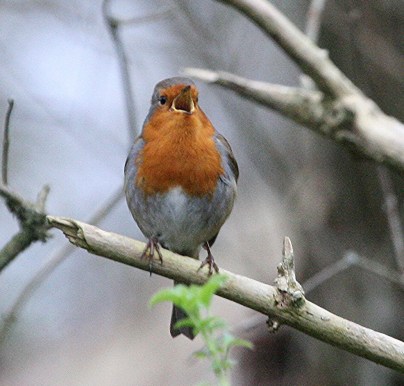
Rock
or Meadow Pipit?
Peter
Milinets-Raby thinks my first impression about the
small bird at Nore Barn yesterday was probably
correct. He said, " . . it looks good for a Rock Pipit
to me. The legs are the right colour! A funny dirty
burnt reddish brown. Meadow Pipit is indeed much, much
paler. Also stocky bill distinctive. And the way the
belly and flank streaks form parallel streaks is also
diagnostic to Rock Pipit." That's interesting as it
was only after seeing the pinkish legs on the photo
that I changed my ID from Rock Pipit to Meadow Pipit.
Rock Pipit certainly fits the habitat much better than
Meadow Pipit. I usually rely on leg colour as a key
distinguishing mark.
Here is the Rock
Pipit (?) from Nore Barn
alongside a Meadow Pipit from Thorney Island.
Birds
of Warblington and Emsworth
Readers of
this blog will be very familiar with the regular
counts by Peter Milinets-Raby of the birds along the
coastline from Emsworth to Langstone. Peter has now
summarised his findings from 2013 to the end of 2015
in a comprehensive report which can be seen on his own
personal web site. This is an update of Peter's
earlier report up to 2014. He says if there are any
mistakes or any new data to be added then please get
in touch with him. . . . http://www.peterspurplepages.webspace.virginmedia.com/EmsworthWarblingtonReport2015_Update_2.pdf
Peter is to be
congratulated on a fine piece of work with lots of
interesting data about all the species he has seen
along this stretch of coastline. The report is
beautifully presented with many fine photos of the
birds. There is no doubt in my mind that Peter has
done more than anyone in providing a comprehensive
overview of the birds in this area and has certainly
put the area firmly on the ornithological map. It has
been somewhat neglected in the past. Well done Peter.
THURSDAY
JANUARY 28 - 2016
Nore
Barn
I paid a quick
visit to Nore Barn at 12 noon, about 2 hours before
high water. The tide was already well advanced and the
stream rapidly filling up. However, the ever-faithful
Spotted Redshank was present, feeding serenely
in the stream in the warm winter sunshine. I took a
few photos. Do I detect some darkening of its plumage?
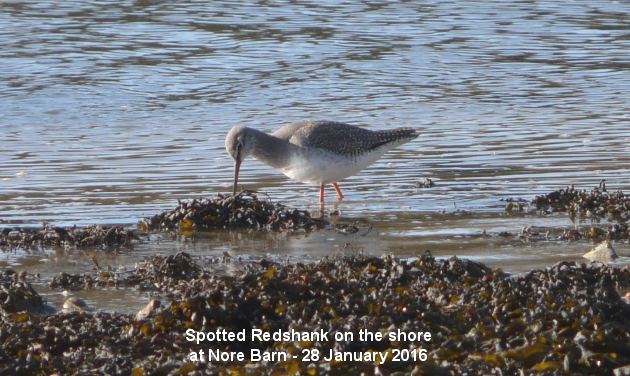
I pointed out the
Spotted Redshank to a passing photographer from Pagham
who was delighted to see the bird and hopefully got
some nice photos.
While I was watching
the Spotted Redshank a Pipit flew in, landed briefly
on a seaweed covered rock for no more than 15 seconds
and then was off. My first inclination was Rock
Pipit, but when I saw those pink legs on the photo
I realised it had to be a Meadow Pipit. It just
goes to show that one can't jump to conclusions based
on what one expects to see.
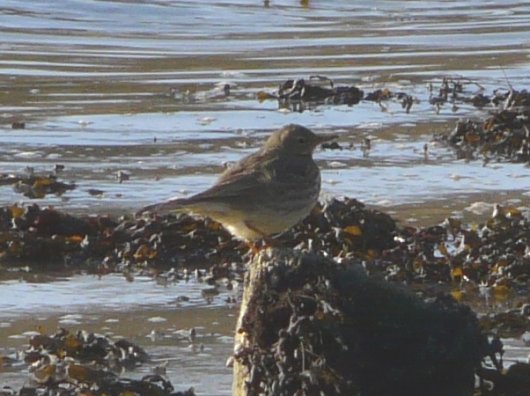
Sweet
Violets
My only other
observation of interest today was of a few Sweet
Violets open on the path behind Lillywhite's Garage.
This is a good spot locally to see these tiny flowers.
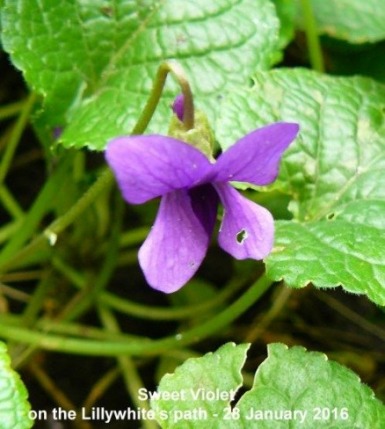
Another good place,
which I have yet to check, is the grass verge on the
north side of Warblington Road just before the
junction with Valetta Park. Ralph Hollins found a
single Sweet Violet flower hidden among its leaves in
St Faith's Churchyard in Havant on Jan 19. I would
think it highly likely that the BSBI New Year Plant
Hunt reported in yesterday's blog also had some Sweet
Violets.
Malcolm's
news
Malcolm
Phillips went round the meadow late morning. He saw a
Goldcrest very active by the south bridge and a Great
Spotted Woodpecker in the trees by the sluice gates.
Malcolm got photos of a Blue tit and female Reed
Bunting at the top end of Peter Pond. It is good to
know that Reed Bunting is still in the reeds on Peter
Pond, hopefully to breed there. As for the Blue Tit, a
very common bird I know, but I find Malcolm's photos
of the bird quite irresistible!
Garden
Sparrowhawk
Caroline
French is certainly getting some good birds in her
garden recently. She's had Brambling and Siskin, but
today she had one that beat the lot - a Sparrowhawk.
It caught a male Blackbird in her neighbour's garden,
brought it over the fence, killed it quickly and made
short work of plucking and eating it. Wow! Garden
birdwatching does not get any better than this! I
agree with Caroline that it is a juvenile Sparrowhawk
due to the brown back and broken barring on the
breast.
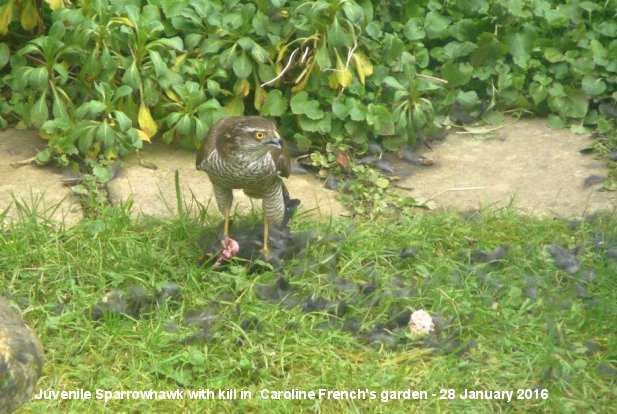
WEDNESDAY
JANUARY 27 - 2016
Garden
Siskin
Caroline
French was delighted to have a single male Siskin on
her feeder today, the first she has seen since March
2013. She watched it feeding on the kibbled sunflower
hearts for about five minutes, then a Greenfinch
arrived and there was a bit of an altercation and the
Siskin flew off. Caroline apologises for the poor
quality of the photos - taken through a wet window and
the rain.

Siskins look very
similar to the far more common Greenfinches, so it is
worthwhile checking your Greenfinches for any Siskins.
This is certainly the best time of the year to see
these birds. Here is Caroline's shot of the Siskin
with a Greenfinch.
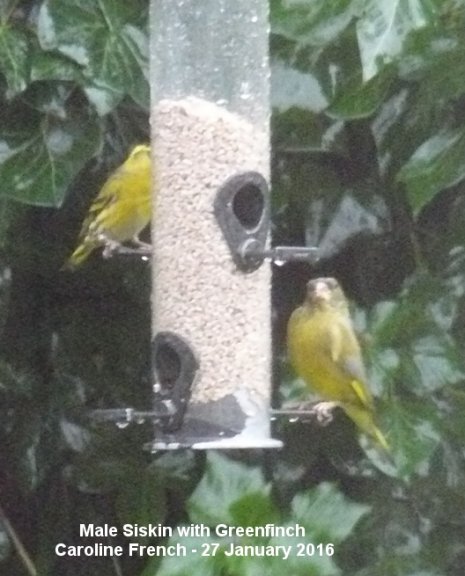
Siskin is quite a rare
garden bird, though its frequency varies from one year
to another. For example in the period Jan-Mar 2014 it
was reported by about 10% of people taking part in the
BTO Garden BirdWatch scheme who lived in the South
East (ranked overall 25th), but in Jan-Mar 2015 it was
reported by only 2.5% of participants and its ranking
had fallen to 35th.
The
last Siskins I had in my Emsworth garden were in Feb
2004
Here is a male, though I also had a female without the
dark head
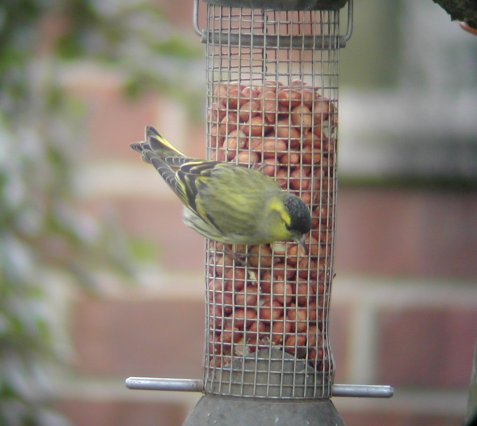
Seabird
news
Great Northern
Diver and Red-necked Grebe were still present in the
main channel to the north of Northney Common
yesterday. Reported to HOS by R Ford
New
Year Flower Hunt
More than 850
members of the Botanical Society of Britain and
Ireland (BSBI) spent up to three hours between 1st and
4th January hunting for wild plants in flower on their
local patches for the fifth BSBI New Year Plant Hunt.
The results were amazing. A total of 8,568 records of
plants in flower were submitted from across Britain
and Ireland which included 612 different species; this
was a huge increase over last year when only 368 were
found.
BSBI's Head of Science Dr Kevin Walker said "There
does not seem to be any real indication of an early
spring. Spring-flowering specialists, such as Lesser
Celandine, Cow Parsley and Sweet Violet, were widely
recorded but they make up less than a fifth of the
total. At least three quarters of the plants recorded
were 'Autumn Stragglers' like Yarrow, Red Campion and
Red Dead-nettle that had carried on flowering in the
absence of a hard frost. The two most commonly
recorded plants were Daisy and Dandelion - which we
would expect to be flowering at this time of year.
Perhaps more surprising was Hawthorn in bloom!"
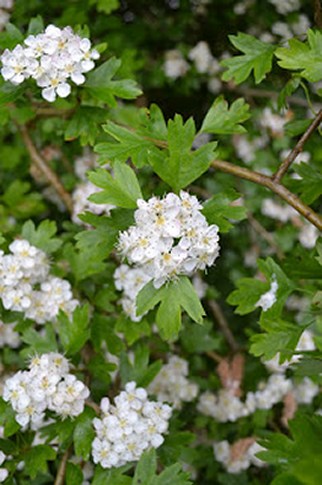
The 612 species in
flower represents about a quarter of the species that
occur regularly in Britain and Ireland. A number of
these are aliens from warmer climates that may have
escaped from gardens or cultivation and are continuing
to flower until winter frosts knock them back. As in
previous years, urban areas tended to have more
species in flower than rural areas. This is to be
expected: there are more sheltered and disturbed areas
with warm micro-climates where native and alien
plants, including garden escapes, can thrive.
For more details see . . . http://bsbipublicity.blogspot.co.uk/2016/01/bsbi-new-year-plant-hunt-2016-results.html
I will try to get hold of the complete list.
TUESDAY
JANUARY 26 - 2016
Slavonian
Grebe
Tony Wootton
sent me photos of two cracking birds that he took at
Keyhaven a couple of weeks ago, Spoonbill and
Slavonian Grebe. We have had a few Spoonbills in this
blog before, but never a Slavonian Grebe.

Slavonian Grebe is a
scarce winter visitor and passage migrant to the south
coast of Hampshire. According to the Birds of
Hampshire they are most seen in three localities,
Black Point/Hayling Bay, Lepe/Needs Ore and
Lymington/Hurst. Numbers are generally in single
figures, so it is far from a common bird. However,
2014 was an above average year with a peak of 35
present in mid-February.
Slavonian Grebe has a near circumpolar breeding range
from Iceland in the west through central Asia and
North America as far as the Great Lakes. There is a
small but declining Scottish breeding population with
34 pairs raising 10 young in 2012. I was fortunate to
see some Slavonian Grebes in breeding plumage on Lake
Ruthven during a holiday in northern Scotland in May
2004. Here is my digiscoped shot from the lakeside.
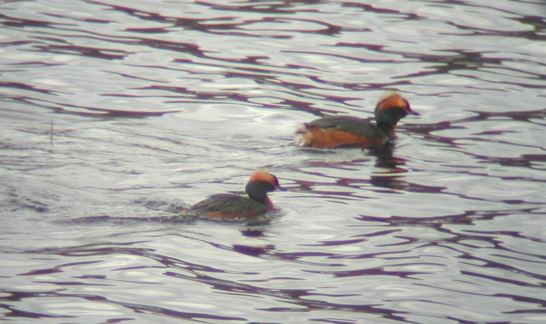
Cuban
Wildlife
Malcolm
Phillips did not have much to report on locally, so he
sent me a couple of pics he got while on holiday in
Cuba which he thought would lighten up a very dull and
dismal day. Does anyone know know what they might be?
Little
Auks invade Scotland
RSPB Scotland
reports that thousands of Little Auks have been driven
from their normal wintering grounds off Scandinavia by
stormy easterly winds and have been appearing inland
in Scotland in unprecedented numbers. One even turned
up in a garden, the first ever Little Auk recorded on
the BTO Garden BirdWatch scheme. The Scottish SPCA has
been caring for more than 100 Little Auks at its
National Wildlife Rescue Centre in Fishcross. For more
details and a fascinating video of the Little Auks in
the rescue centre see . . . http://www.bbc.co.uk/news/uk-scotland-35249939
Goldfinches
prefer sunflower hearts
Two months
into the Goldfinch Feeding Survey it seems that
sunflower hearts are more tempting to Goldfinches than
niger seed or other food types. This is certainly no
surprise to me as Goldfinches abandoned niger seed in
my garden many years ago and now hardly ever touch
anything else than sunflower hearts. You can still
take part in the survey by going to . . .
http://bto-enews.org/NXK-3YVIN-3UEDCR-1Y16FF-0/c.aspx
Monthly
pattern of garden use
BTO has a
fascinating web page showing in graphical form how
different species use Garden BirdWatch gardens month
by month throughout the year . . . http://www.bto.org/volunteer-surveys/gbw/results/annual-patterns-garden-use?dm_i=NXK,3YVIN,3UEDCR,EBPJA,0
MONDAY
JANUARY 25 - 2016
Brook
Meadow
Malcolm
Phillips was on Brook Meadow today and got the
first Cetti's Warbler of the year by the sluice
gates.
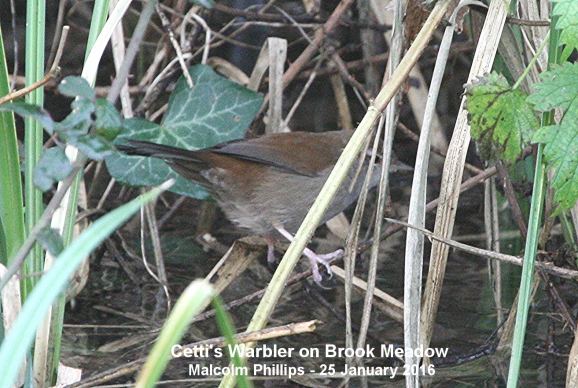
Last year a Cetti's
Warbler was regularly seen around the meadow or in the
Peter Pond reedbeds from 19-Feb-15 until the summer.
On 05-Jul-15 Malcolm got a photo of one with food
probably for nestlings which was a good indication of
breeding success. Let's hope they do as well this
year.
Malcolm
also got a nice shot of a Goldcrest - but no Firecrest
as yet.
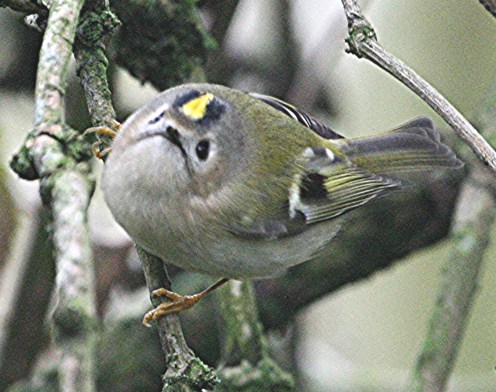
Finally, Malcolm
spotted this tuft of smooth, bell-shaped,
sulphur-yellow fungi with tan centres growing on a
dead log. My guess is they are young Sulphur Tufts
which are fairly common in this habitat (though I
could be wrong).
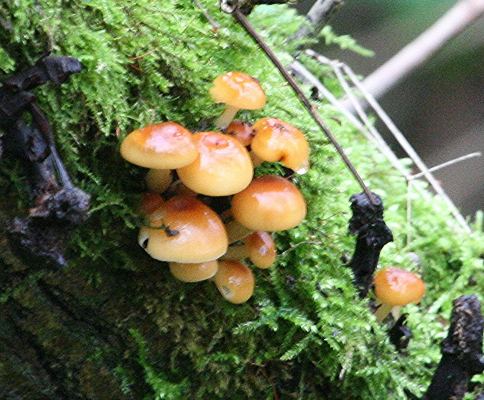
SUNDAY
JANUARY 24 - 2016
Special
birds on millpond
My walk around
the town millpond this morning was enlivened by
five Red-breasted Mergansers, two male-female
pairs and an extra female/juvenile. These beautiful
birds have been regular visitors to the pond over the
past few weeks and have attracted a good deal of
attention from people walking past. They are fairly
easy to photograph. Here is my snap from this morning
showing one pair with the spare female in the
background.
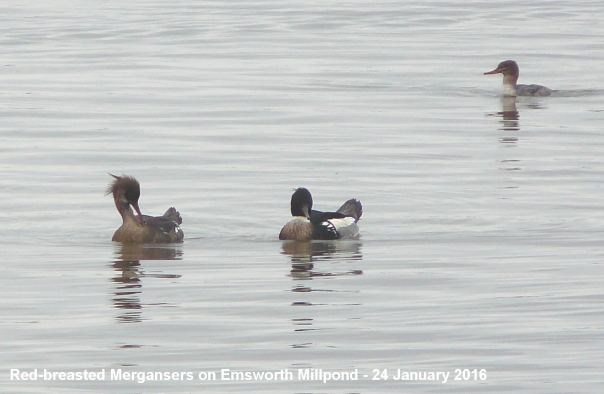
But much better than
that was a single female Goldeneye busily
fishing on the pond. This was not entirely unexpected
as Peter Milinets-Raby had seen three Goldeneyes (one
male and two females) in the harbour yesterday and I
was hoping they might find their way onto the pond. I
can't find the record when I last saw a Goldeneye on
the town millpond, but it must have been a very long
time ago - 20 or 30 years maybe. Here are two shots I
got of the bird for good measure.
Goldeneye breed mainly
in Scandinavia with a few in Scotland and are
widespread around the British coastline in winter. The
Birds of Hampshire report that the wintering
population of Goldeneye is declining in Hampshire,
though numbers rise in cold winters. In 2014 just 20
were recorded in Chichester and Langstone Harbours
combined (from Hampshire Bird Report) so they are far
from common birds.
Juvenile
Cormorant
I also had a
quick look at Slipper Millpond where I found a
juvenile Cormorant basking on the south raft sometimes
with its wings extended. The very white fluffy
underparts of this Cormorant strongly suggests it is a
first year bird born last spring. The dark adult
plumage of the Cormorant is gradually acquired over a
2 year period.
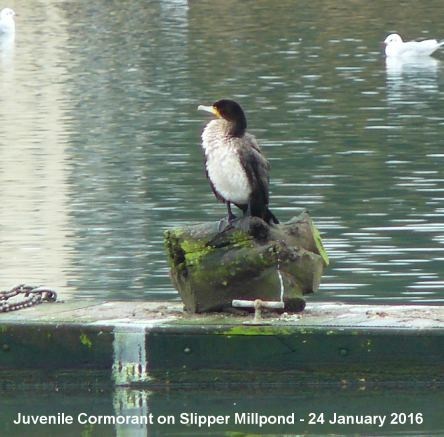
Gulls
galore
The only other
birds of interest on Slipper Millpond were a large
flock of around 500 Black-headed Gulls. I went through
them and noted a few Common Gulls, but most were
Black-headed. Here is my shot of a few of them.
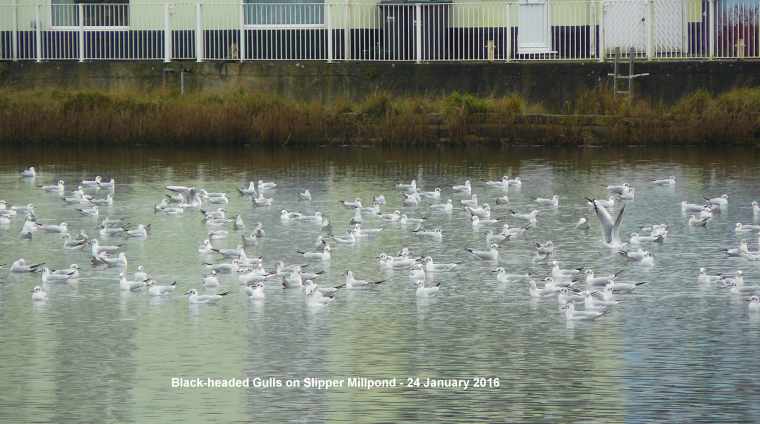
Song Thrush song
Finally,
making my way home through Brook Meadow I was pleased
to hear my first Song Thrush in full song from the top
of the Weeping Willow tree just below the causeway.
This was very likely the same bird that I watched
extracting a snail from its shell at this spot on Jan
21. In fact, Song Thrush has been vocal for a little
while; David Minns heard two singing on Brook Meadow
on Jan 8 and Ralph Hollins has also reported them
singing in the Havant area.
Here
is the Song Thrush singing its heart out on Brook
Meadow
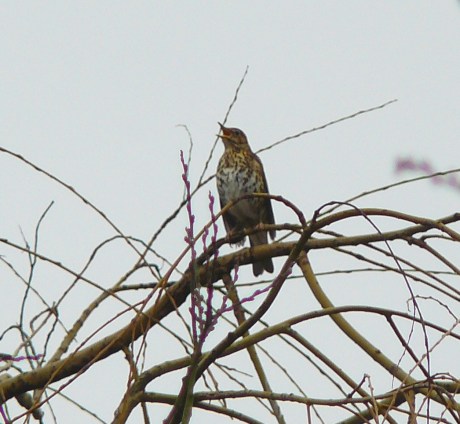
SATURDAY
JANUARY 23 - 2016
Emsworth
to Nore Barn
Peter
Milinets-Raby was out this morning 7:43am to 9:28am -
tide nearly in - dense fog! Because of the tide
pushing in quickly I only had time to visit Emsworth
and Nore Barn. The highlights were as follows:
Emsworth Harbour: 40 Coot, 215 Brent Geese, 3
Canada Geese, 1 male and 3 female Red Breasted
Merganser, 9 Gadwall, 12 Lapwing, 1 male and 2
female Goldeneye, 41 Shelduck, 1 Little Grebe, 1
Great Crested Grebe, 3 Grey Plover.
Peter's
photo of a male Goldeneye in Emsworth Harbour
This was the first Goldeneye of the winter in Emsworth
Harbour.
Look out for them on the town millpond possibly?

Emsworth Mill
Pond: 2 male and 3 female Red breasted Merganser,
9 Coot, 2 Cormorants,
Off the pond outflow: 178 Dunlin, 17 Turnstone,
3 Teal, 15 Wigeon, 227 Brent Geese,
Beacon Square from 8:25am: 35 Wigeon, 10
Turnstone, 36 Brent Geese, 24 Dunlin, 1 Black-tailed
Godwit, 1 Grey Plover.
Nore Barn from 8:40am: 27 Wigeon, 1 Spotted
Redshank with usual Greenshank in the stream, 22 Brent
Geese, 7 Teal.
Took a walk along the shore to the real Conigar Point
- very foggy
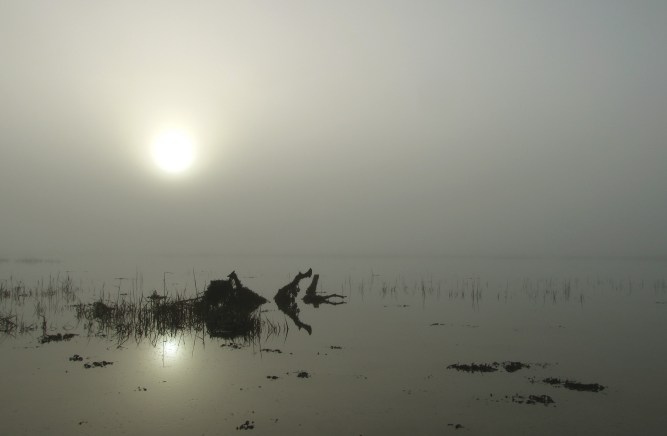
In pool at top end a
pipit sp that looked more like a Water Pipit
than Rock Pipit - alas it did not call and slipped
away at the back of the pool and out of sight!
Spoonbill
Barry &
Margaret Collins saw a first winter Spoonbill roosting
on the west side of the Great Deep on 20 Jan. Then on
a falling tide it flew E high over the Island and into
Chichester Harbour.
This bird could well come over to Emsworth Harbour.
The last Spoonbill seen locally was a juvenile/first
winter by Peter Milinets-Raby flying over Conigar
Point on Sunday 8 Feb 2015. The only Spoonbill I have
seen in Emsworth Harbour was in Dec 2002. A memorable
occasion! Here is a photo I got of it on the town
millpond.
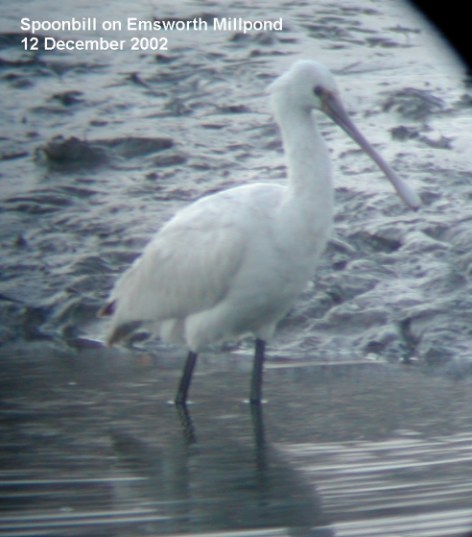
FRIDAY
JANUARY 22 - 2016
Langstone
Mill Pond
Peter
Milinets-Raby popped down to Langstone Mill Pond after
the rain (1:45pm to 3pm - tide dropping fast). Birds
of note: female Kingfisher on the seaweed posts in the
mill outflow. Used up 40 minutes of my visit taking
photos!!

Off Pook Lane: 1
Greenshank, 7 Red Breasted Merganser, Male &
female Goldeneye, 59 Lapwing, 55 Shelduck with a
further 20 off Conigar Point, 80+ Dunlin, 6 Grey
Plover, 60+ Brent Geese.
Pond: 2 Teal, Male Siskin with 20+ Goldfinch, Five
nests occupied.
Flooded paddock: 9 Little Egrets, 77 Teal (see photo
of male Teal), 3 Oystercatcher, 1 Curlew, 23 Wigeon
(photo of two female Wigeon), male Pheasant, 2 Mistle
Thrush (one later singing), 26 Moorhen
THURSDAY
JANUARY 21 - 2016
Brook
Meadow
I went over to
the meadow this morning for the regular conservation
work session, not to work, but to take photos of the
volunteers working! The weather was fine and there was
a good turn out of 12 volunteers. The main tasks were
to continue to cut and clear the Seagull Lane patch
and to strim the new experimental wild flower area in
the north meadow. A small area has been sown with wild
flower seeds from a local site and the strimming might
help to keep the coarse grasses at bay.
A
band of people worked to clear and widen the main
raised path
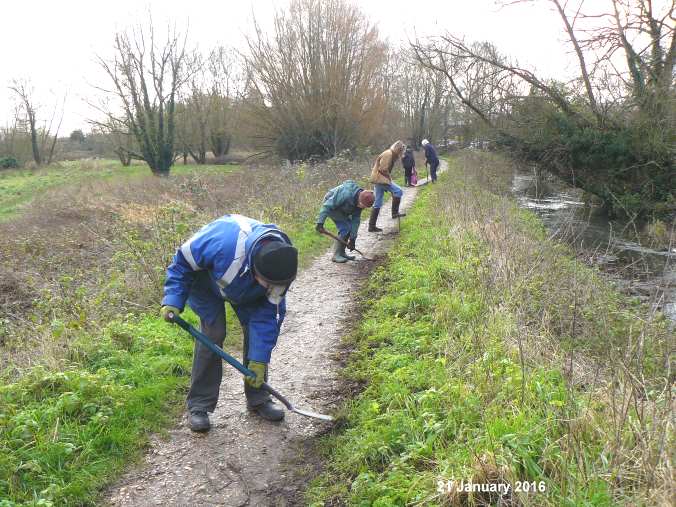
For the full report
and more photos go to . . . http://www.brook-meadow.hampshire.org.uk/bm-diary-current.html
The
river was running high and the path through Palmer's
Road Copse was partially
flooded
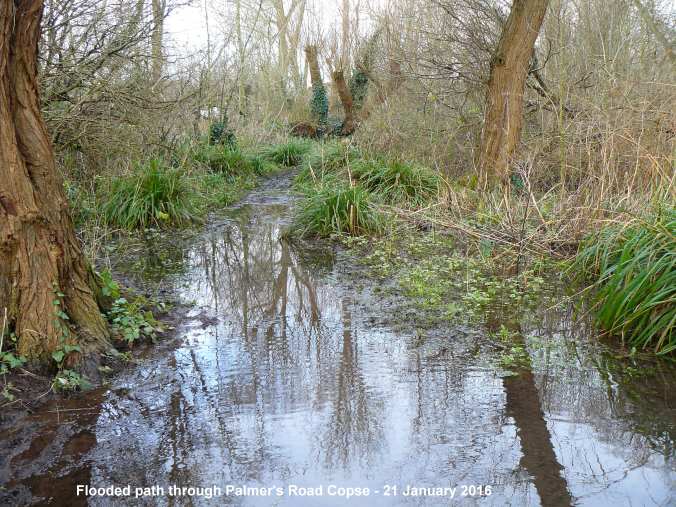
Here are a couple of
shots I got yesterday. One of the regular pair of
Carrion Crows foraging around on the grassland. And a
Song Thrush extracting a snail from its shell.
Slipper
Millpond
Malcolm
Phillips captured a juvenile Herring Gull in flight,
seemingly diving to retrieve some morsel of
food.

WEDNESDAY
JANUARY 20 - 2016
Garden
Blackcap
I was pleased
to see my first (female) Blackcap of the winter in my
garden this morning, feeding on the fat balls. Good to
see and I hope to get a male fairly soon!
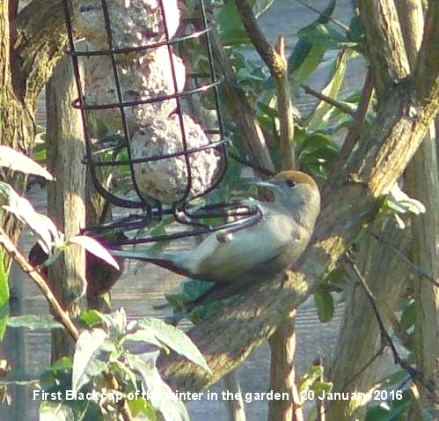
Brook
Meadow
I had a lovely
walk through Brook Meadow this morning in winter
sunshine to collect my car from Lillywhite's Garage. A
hard frost overnight had left the grassland and other
vegetation with a silver covering. Robins were singing
everywhere and I heard a brief burst from a Blue Tit -
first of the winter. Wrens were darting around on the
river banks and a pair of Carrion Crows were foraging
on the grassland. I watched a Song Thrush
extracting a snail from its shell. As Ralph Hollins
noted in his wildlife diary, Moles are now
digging news tunnels in the search for worms and I saw
several fresh ones on the meadow.
Nore
Barn
11:00 - Tide
falling. The Spotted Redshank was feeding on
the shoreline at the end of Warblington Road along
with two Dunlin and a Grey Plover. More interesting
was a flock of 64 Black-tailed Godwits at the
top of the Nore Barn channel. The sun was not good for
photography. I went through most of them for rings,
but did not find any.
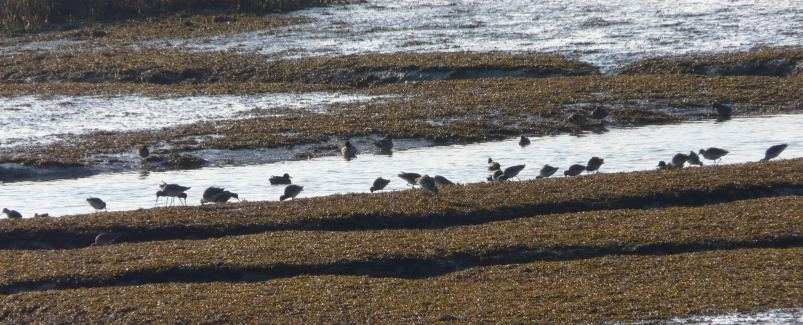
There were also plenty
of Wigeon and Teal milling around, but I did not see a
single Brent Goose. Very strange.
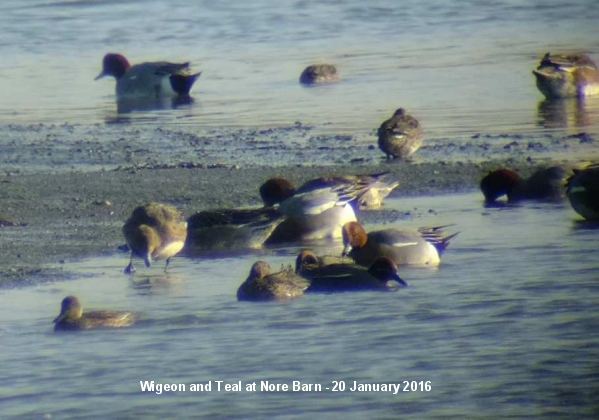
Malcolm Phillips was
also at Nore Barn this afternoon and saw similar birds
to me, but in addition got some good photos of them as
follows. Male Teal, Dunlin, Grey Plover and Common
Redshank.
Interestingly, Charlie
Annalls also saw a Grey Wagtail during a visit
to Nore Barn last Saturday. That is quite an unusual
bird to find there.
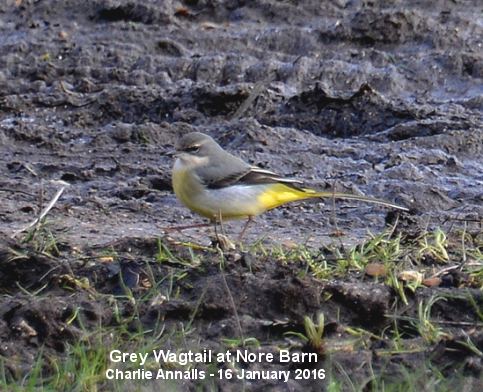
Mergansers
on the millpond
Jennifer Rye
spotted six Red-breasted Mergansers on the town
millpond this morning. This is the most so far this
winter.
Prinsted
Short-eared Owl
Juliet Walker
cornered me at table tennis this afternoon to describe
a bird she had seen during a walk along the shore from
Prinsted to Nutbourne. Juliet said it was flying low
over the first field to the west of the Nutbourne
reedbeds and from her description there was no doubt
whatsoever that the bird she had seen was a
Short-eared Owl. I can't recall her exact words, but
they went something like this: 'A large owl-like bird
flying with slow wing beats, low over the grassland,
with frequent banks and glides, occasionally dropping
onto the ground'.
Short-eared Owl is the only British owl that regularly
hunts during the day. I vividly recall seeing seven of
them quartering a field near Tournerbury Wood on
Hayling Island many years ago. This past winter
several have been seen over Farlington Marshes and
occasionally over Thorney Island, but this is our
first sighting at Nutbourne.
Here is a superb image of one quartering over Thorney
Deeps that Romney Turner captured in Jan 2012.
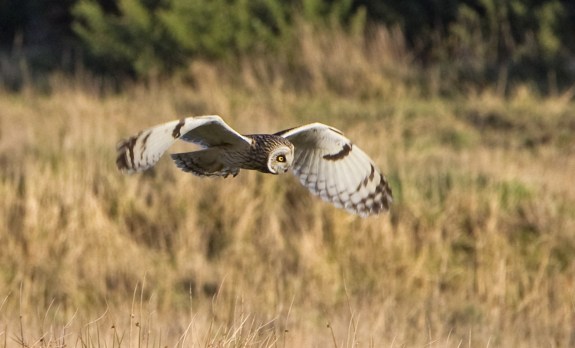
And this is what it
looks like when perched - with yellow eyes glaring out
of a white face - which I managed to get during a WeBS
count on Tournerbury Farm in Nov 2006.
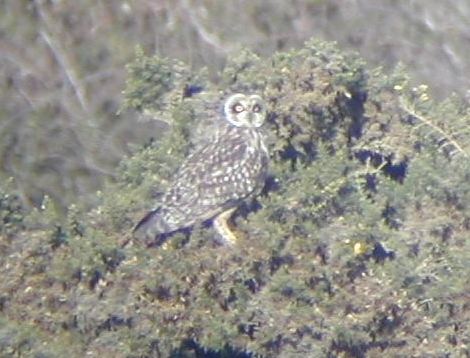
Penduline
Tits
After five
visits over the last 6 weeks, so probably 10-12 hours
of devoted vigilance, Tony Wootton finally achieved
his goal today - a 10 minute sighting of two Penduline
Tits at Meadow Hide at Titchfield Haven. So well done
Tony. I certainly have never seen one of these birds.
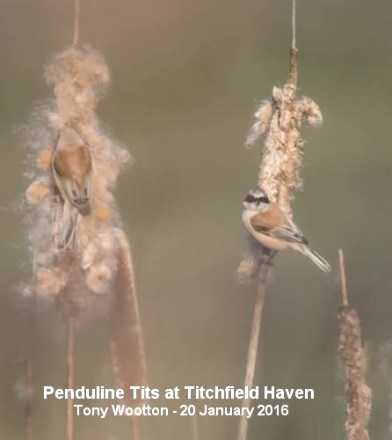
Penduline Tits are
very rare birds indeed, particularly in winter, but
The Birds of Sussex reports a surge in records of this
'curious little wetland bird' though, even here, we
are talking of no more than four sightings a year and
sometimes none at all. The last recorded in Hampshire
according to the new Hampshire Bird Atlas was two at
Titchfield Haven in 2010. The name Penduline comes
from the hanging pouch-like nests which the bird
weaves and decorates with Willow down.
TUESDAY
JANUARY 19 - 2016
Colour-ringed
Greenshank
On my walk
this morning I found a single colour-ringed Greenshank
feeding busily in the low water channel near the quay.
The rings came out clearly in the photo as - RG+BY
tag . This bird was ringed on 19-Mar-13 by Pete
Potts and his team at Thorney Deeps and fitted with a
geolocator to the blue ring. It is seen regularly in
Emsworth Harbour - this being my 4th sighting this
winter.
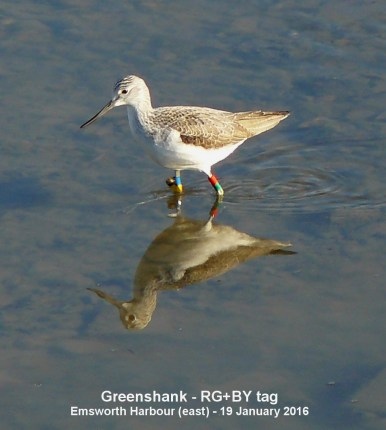
Red-breasted
Mergansers
A pair of
Red-breasted Mergansers on the town millpond was
attracting a lot of attention from passers-by. Here is
a shot of the very handsome male. Look at that crest
and those eyes! Who could resist him?

Garden
Magpies
While having
lunch, my wife and I were entertained by a flock of
7 Magpies that descended into the garden. The
photo shows just 5 of them. This is by far the largest
number of Magpies I have ever recorded in my present
garden.
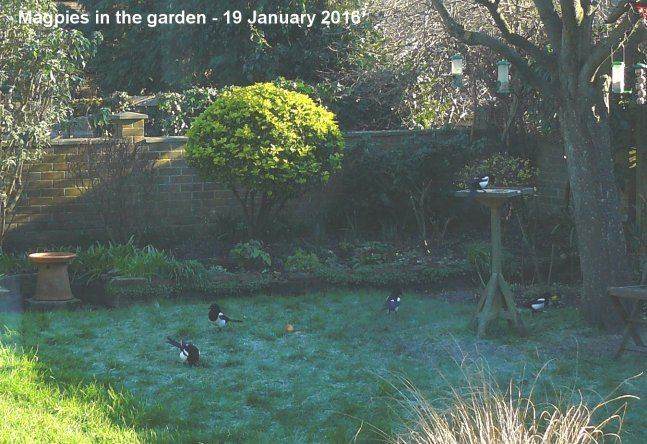
The Magpie is, of
course, a fairly common garden bird. At this time of
the year it is ranked 7th in the BTO Garden BirdWatch
list with a reporting rate of 67%. The average monthly
maximum count at this time of year is 1.3 so having 7
at one time is clearly quite exceptional. The
following chart shows the average monthly maximum
count in the Garden BirdWatch scheme for 2015 (blue
line) and across all years (dotted line).
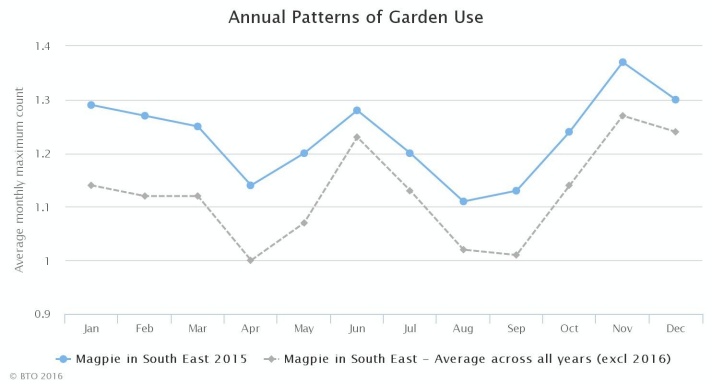
Malcolm's
photos
Malcolm
Phillips went round Brook Meadow today and got a
couple of nice photos - Robin and Dunnock.
Hayling
Billy Line
Mike Wells
took a very cool stroll along the Old Hayling Billy
Line this morning and saw a rare sight of the 'field
side' flooded and frozen - Barn Owl or Short-eared
Owl? Sadly, after zooming in Mike said it was not an
owl but a man-made structure. How disappointing.

Mike also got a photo
that made him smile, a Kestrel with Goldfinches
sitting behind it which made me think of the obvious
panto line!

Thorney
Heron
Jill Stanley
was out walking with a friend along by Thorney Deeps,
and enjoying this glorious day, when they spotted this
beautiful Grey Heron just standing, stock still, on a
fence post. They watched it for several minutes before
it flew off, circled round, and came to rest in the
harbour where the tide was out.

MONDAY
JANUARY 18 - 2016
Emsworth
Millpond
My morning
constitutional around the millpond this morning was
considerably enlivened by the presence of a pair of
magnificent Great Black-backed Gulls. It is very
unusual to see these two large gulls on the town
millpond. My guess is that they are the Slipper
Millpond breeding pair returning to the area for
another season.
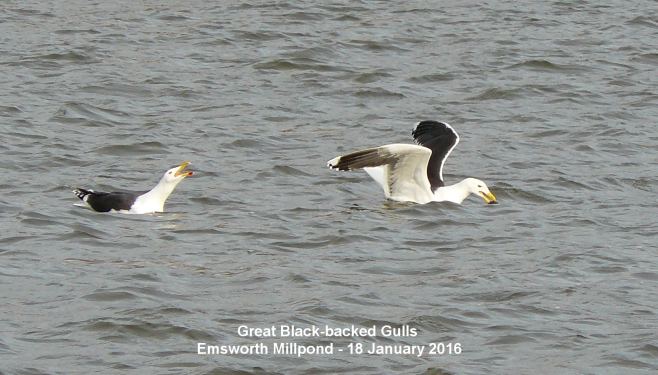
A pair of Red-breasted
Mergansers was also fishing in the northern part of
the pond close to the path.
Garden
Blackcap
Chris Oakley
has had a male Blackcap in his North Emsworth garden
for about a week and says it feeds happily on
sunflower hearts with the hoards of Goldfinches and
Greenfinches, though it has ignored the sponge cake
that Chris put out for it.
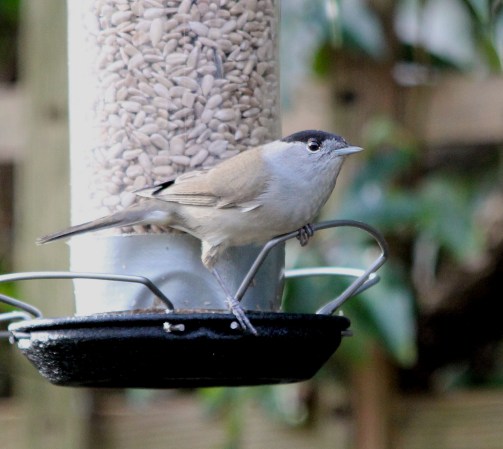
The sponge cake idea
originally came from local ecologist Graham Roberts
who was one of the first to discover that Blackcaps
migrate to Britain from the Continent in winter. But
that was before the widespread use of sunflower hearts
- now there is no going back!
Farlington
Marshes
Dave Perks
joined 14 other hardy souls on the HOS walk around
Farlington Marshes yesterday. He reports as follows:
"I can confirm the sighting of a Spoonbill flying
north east from the harbour over the reserve at about
12 noon as reported on your blog. There was also the
regular flock of about 30 Avocets feeding on the mud
between the sea wall by the lake and the Eastern Road
shore and a Short-eared Owl quartering the field close
to the point. There were also good but fairly distant
views of at leasr 4 Bearded Tits in the reeds on the
far side of the lake. Black-tailed Godwits were almost
completely absent apart from a flock of about 30 in
the fields by The Deeps. Plenty of Brent Geese and
Wigeon and also a fair number of Pintail but we didn't
see many Shovelers."
Spurting
Spoonbill
Tony Wootton
got this shot of a Spoonbill 'spurting' at Keyhaven on
Saturday.
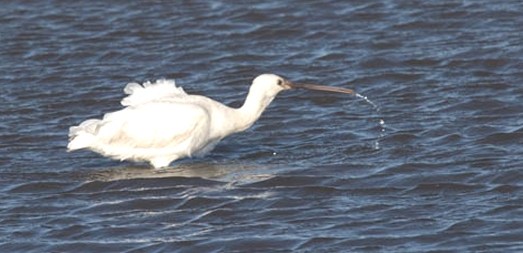
For more information
about this behaviour which continues to puzzle the
experts go to . . . Spurting
behaviour .
This link has lots of photos of waders spurting,
including on of the one and only Spoonbill at Emsworth
also spurting in December 2002.
Black-tailed
Godwits
Steve Gale
counted 900 Black-tailed Godwits from a photo at
Pulborough Brooks today! So that's where they have got
to. He counted every single one of them! See the photo
on his blog at . . . http://northdownsandbeyond.blogspot.co.uk/
Other
news
11 Purple
Sandpipers roosting in rock crevices above the high
tide at Southsea Castle at 16:30 today.
41 Mute Swans on Canoe Lake, Southsea today. They are
coming back to the lake!
For a quick summary of the wildlife news over past two
weeks
go to . . . Wildlife
News Summaries
For
earlier observations go to . . January
1-16